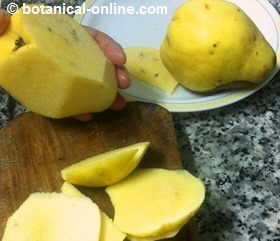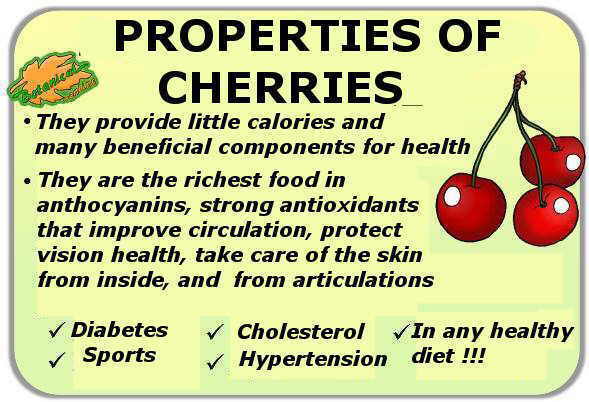Contents
- 1 MEAT PROCESSED IN FOOD
- 1.1 What is processed meat?
- 1.2 Origin of processed meat
- 1.3 Methods of processing meat
- 1.4 Properties of processed meat
- 1.5 Is processed meat recommended? Why?
- 1.6 Problems of processed meat
- 1.7 Processed meat is very rich in salt
- 1.8 Eating so much salt is not natural
- 1.9 Processed meats are very rich in fat
- 1.10 Additives and carcinogenic substances in processed meat
- 1.11 Why is so much processed meat consumed?
- 1.12 Other hazards of processed meat
MEAT PROCESSED IN FOOD
What is processed meat?
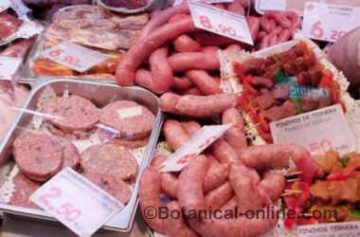
Processed meat or meat products are products derived from the processing of meat to improve its flavor, texture, aromas and / or preservation.
The term processed meat includes the meat derivatives that come from both red and white meat.
Origin of processed meat
Processed meat is not a modern product, quite the opposite. It has its origin in the preservation of meat to prevent its biological deterioration.
Finding methods to preserve meat has been a challenge throughout the history of mankind, for this reason many techniques are known: salting, smoked, … For example, salting and curing meat is a process that is already described in the texts of the Roman writer Cato (50 BC). The addition of salt, spices and other preservative techniques allows the meat to be preserved for a long time without being affected by bacteria that deteriorate it.
However, the current high availability of food does not require the use of these meat preservation techniques. If they continue to be consumed it is because they are more palatable and tasty products than the “not processed” meats from which they come, since they contain more fats, salt and aromas.
Another objective of making these products is to take advantage of all the by-products of the production of meat, which are edible and nutritious, such as blood, liver, fat or viscera.
Methods of processing meat
The most common methods of processing meat are: minced meat, salted meats, sausage, marinade, smoked, pâtés, … Also in all these processes is added salt, preservatives ingredients and seasonings to improve the taste of the meat.
Examples of processed meat are: cold cuts, sausages, frankfurters, hot dogs, pork or chicken sausages, salami, chorizo, bacon, pancetta, ham or cooked ham…
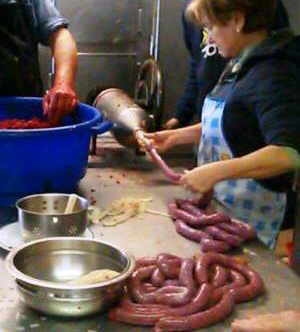
Properties of processed meat
Processed meat has no better nutritional properties than fresh meat and is a totally dispensable food.
In general, processed meat shares the nutritional characteristics of meat, which is a food rich in proteins, animal fats, B vitamins (especially biotin, niacin, vitamin B12), iron and zinc. If the meat comes from grass animals, it may contain a certain amount of essential fatty acids or good fats.
Processed meat contains more salt and more fats than “unprocessed” meat, so it is more palatable and more pleasant to taste.
Compared to meat, processed meat has disadvantages because, due to its additives, it contains more toxic substances.
Is processed meat recommended? Why?
No, processed meat is never an advisable option because it does not provide any nutrients that are not provided by other non-processed products. If meat is consumed, processed meat should be reserved only on special occasions, festivities or on a frequency of consumption that is not usual or weekly.
- It should be noted that currently it is not necessary to eat meat to be healthy, because fortunately, there are enough resources to carry a complete and healthy vegetarian diet, properly planned.
Problems of processed meat
One of the current problems in food is that in some countries, many people consume processed meat several times a day, while these foods should be reserved for occasional consumption. Among the main problems that can lead to the habitual consumption of these foods is:
Processed meat is very rich in salt
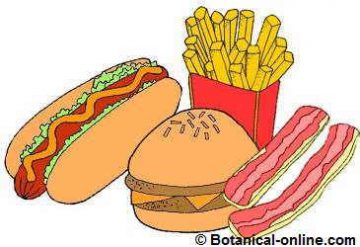
Salt is always added to processed meat, for its flavor and for its preservative function, which prevents the development of microorganisms. In addition, in the sausages, cured and salted products, salt helps to solubilize the proteins and serves to improve the texture of the meat, obtaining more compact and tender fibers.
For these reasons, all types of processed meat are very rich in salt (they must be rich in salt to obtain the desired product characteristics). In addition, processed meats are usually combined with foods that also contain enough salt, such as bread, chips, snacks, pizzas, etc., with the consequent overeating or excess sodium.
Salt is necessary in moderation, because it helps us to be hydrated, but currently the majority of the population consumes it in excess.
Eating so much salt is not natural
Never before in the history of mankind had there been so much salt in the diet. The availability of high salt foods has never been as extensive as it is today. Physiologically, the body is not prepared to eat so much salt and eliminate such high amounts of sodium, which it tends to retain. Too much sodium makes many diseases worse, such as fluid retention, gout, lupus, diabetes, etc. In addition, a relationship between high salt diets and the increased risk of stomach cancer and osteoporosis has been observed.
Processed meats are very rich in fat
All types of processed meat are added with fat or bacon to make them more palatable and tasty. The consumption of such palatable foods makes natural foods such as legumes, vegetables and fruits less attractive, especially on the part of children and young people, who get used to obtaining energy from very salty and fatty foods, which predispose to obesity .
Some processed meats, such as sausages, can contain up to 70% fat, so they can be a great contribution of energy, which if not burned, will easily become body fat. For this reason, people with obesity should not eat processed meat. Even in people with a normal weight, when they eat these foods should be done in moderation.
- The type of fat that contains processed meat is mainly monounsaturated fat, saturated fat and high in cholesterol.
Additives and carcinogenic substances in processed meat

Sausages are always added with mandatory preservative additives, which are nitrites and nitrates. These additives become carcinogenic substances called nitrosamines.
In addition, during the curing, smoking or cooking other harmful substances are also formed: dioxins, furans, heterocyclic amines (AHC) and aromatic hydrocarbons (HAP). All of these substances have been linked to the increased risk of cancer.
Therefore, it could be concluded that processed meat is never a recommended option. If eaten, it should be consumed only occasionally in low amounts so as not to ingest large quantities of these components.
To balance its high content of fat and salt, if you eat sausages, you should accompany a good portion of vegetables, such as a broccoli dish, vegetable cream, legumes or a salad.
It is also advisable to consume quality meat. For example, in the case of hamburgers, it is desirable that they chop the meat in front of us at the time of buying and consuming them the same day, instead of buying the trays of minced meat or hamburgers from the supermarket, with added cereals and additives .
* More information: WHO classifies processed meat as carcinogenic
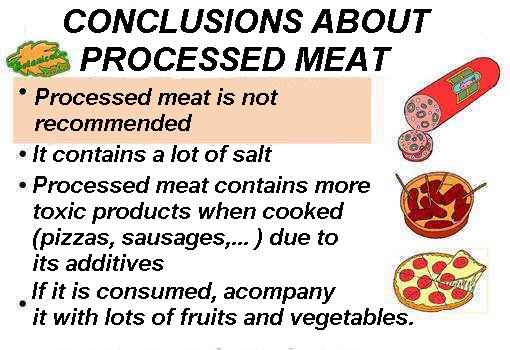
Why is so much processed meat consumed?
If any nutritional pyramid or other feeding guides are observed, processed meats are considered occasional consumption foods. In spite of this, they are consumed too frequently and in unnecessary quantities: sausages, cold meats, hamburgers, meatballs, salted meat, kebab, etc.
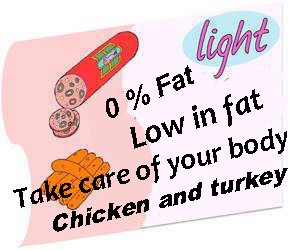
A factor that influences the consumption of sausages is that they are a practical and fast food to eat, which allows to avoid cooking time to eat protein-rich foods between meals. The main problem of obesity is precisely fast food.
In addition, products such as cold cuts are advertised with apparently healthy slogans, such as “low fat”, 0% fats, or as products to watch one’s weight, making us believe that they are foods with benefits to lose weight, which is not true.
This idea has been supported by the fashion of diets to lose hyperproteic weight, such as Atkins’ or Dukan’s.
The dietary recommendation is to consume more nuts and fruits between meals, and to make a good contribution of proteins in the main meals. There is no need to eat protein at all hours, as some unbalanced diets try to promote.
On the other hand, sausages have been part of the culinary tradition of some people and are consumed because they are a food that has always been part of the diet in some families, although they are currently consumed in excess, compared to the diet of grandparents , and in many cases they do not have the same quality.
- It is advisable to have the knowledge, and starting from this point, make a diet as balanced as possible.
* More information: Substitutes of meat and processed meat in the diet
Other hazards of processed meat
Raw processed meat has more toxic hazards than unprocessed meat. Raw minced meat is one of the food products that present the highest risk of contamination by bacteria. If you also buy manipulated products, such as meatballs or hamburgers, you add more chances of contamination, poor conservation, etc. For this reason, when you buy raw minced meat, you should ask them to pike it in front of you.
Although cooking eliminates a certain amount of bacteria, many people have been poisoned by eating poorly prepared meat, improperly preserved or undercooked. However, in establishments that meet food safety and hygiene standards, the risk of poisoning is low. These dangers are much lower in cooked, cured, smoked or sausage meat products, due to their heat treatment and because in these cases preservative additives are added.
![]() More information on meat
More information on meat





